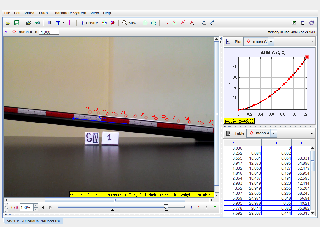

About
For Teachers
Credits
Author: Eka Cahya Prima
Contact: ekacahyaprima@upi.edu
Rolling Cylinders 401 (Advanced Dynamics) by Eka Cahya Prima"
This document investigates highly advanced dynamics of rolling cylinders, incorporating multi-body interactions, external force applications, and energy optimization strategies. It emphasizes the use of simulation and Tracker software to analyze real-time motion data for predictive modeling and applied physics research.
Study Guide:
Objective:
- Analyze the interplay of forces in complex rolling scenarios.
- Explore advanced topics, including rolling under external forces and multi-body dynamics.
Key Concepts:
-
Multi-Body Dynamics:
- Interaction of multiple cylinders rolling in tandem or collision scenarios.
-
External Forces:
- Influence of external factors, such as wind or magnetic fields, on rolling motion.
-
Energy Optimization:
- Strategies for minimizing energy loss and enhancing efficiency in rolling systems.
-
Predictive Modeling:
- Using motion data to forecast future states of rolling systems under varying conditions.
Experiment Overview:
-
Setup:
Experiments involve rolling cylinders subjected to controlled external forces (e.g., air streams, magnets) and collision scenarios with other rolling objects. High-speed cameras and Tracker software record and analyze the motion. -
Procedure:
- Configure experiments with single and multiple cylinders.
- Apply external forces and observe their effects.
- Conduct collision experiments to study energy transfer.
- Record all motion using Tracker for detailed analysis.
-
Observation Points:
- Force-induced deviations in motion paths.
- Energy loss during collisions.
- Long-term stability under multi-body conditions.
Questions to Consider:
-
How do external forces alter rolling dynamics?
- Answer: External forces cause deviations in velocity, trajectory, and rotational behavior based on their magnitude and direction.
-
What occurs during cylinder collisions?
- Answer: Energy and momentum are redistributed, leading to changes in velocity and direction for all cylinders involved.
-
How can rolling efficiency be optimized?
- Answer: Reducing surface resistance, enhancing material elasticity, and streamlining cylinder geometry can improve efficiency.
-
What factors influence stability in multi-body systems?
- Answer: Symmetry, distribution of forces, and interaction points determine the system's overall stability.
-
How does Tracker software enhance these experiments?
- Answer: Tracker provides detailed kinematic data, enabling precise calculation of velocity, acceleration, and force interactions.
Applications:
- Robotics: Designing efficient rolling systems for mobile platforms.
- Transport Engineering: Improving the dynamics of rolling components in vehicles and conveyors.
- Physics Research: Developing predictive models for complex rolling systems.
FAQ:
-
Why explore rolling dynamics at this level?
- Advanced studies provide insights into optimizing energy use and stability in real-world rolling systems.
-
What challenges might arise in these experiments?
- External force application and collision control require precise setups and accurate measurements.
-
Can Tracker simulate external forces?
- While Tracker itself doesn't simulate forces, it captures motion data that can be analyzed to infer force effects.
-
What are potential real-world benefits of this study?
- Findings contribute to innovations in engineering, transport, and energy-efficient designs.
-
How do multi-body interactions add complexity?
- Interactions involve compounded forces and motion variables, requiring sophisticated analysis to fully understand.
Research
http://scitation.aip.org/
- Details
- Parent Category: 03 Motion & Forces
- Category: 02 Dynamics
- Hits: 5053
